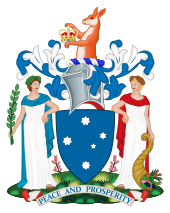
Back Conseil législatif de Victoria French ビクトリア州上院 Japanese Rada Ustawodawcza Wiktorii Polish Victorian Legislative Council SIMPLE
Legislative Council | |
|---|---|
| 60th Parliament | |
 | |
| Type | |
| Type | |
| History | |
| Founded | 1851 |
| Leadership | |
Deputy President | |
Leader of the Government | |
Deputy Leader of the Government | |
Leader of the Opposition | |
Deputy Leader of the Opposition | |
Government Whip | |
| Structure | |
| Seats | 40 |
 | |
Political groups | Government (15) Labor (15) Opposition (13) Greens (4) Legalise Cannabis (2) Animal Justice (1) Libertarian (1) One Nation (1) Shooters, Fishers, Farmers (1) Independent (1) Independent Liberal (1) |
Length of term | 4 years |
| Elections | |
Last general election | 26 November 2022 |
Next general election | 28 November 2026 |
| Meeting place | |
 | |
| Legislative Council Chamber, Parliament House, Melbourne, Victoria, Australia | |
| Website | |
| Vic Legislative Council | |
The Victorian Legislative Council (VLC) is the upper house of the bicameral Parliament of Victoria, Australia, the lower house being the Legislative Assembly. Both houses sit at Parliament House in Spring Street, Melbourne. The Legislative Council serves as a house of review, in a similar fashion to its federal counterpart, the Australian Senate. Although it is possible for legislation to be first introduced in the Council, most bills receive their first hearing in the Legislative Assembly.
The presiding officer of the chamber is the President of the Legislative Council. The Council presently comprises 40 members serving four-year terms from eight electoral regions each with five members. With each region electing 5 members using the single transferable vote, the quota in each region for election, after distribution of preferences, is 16.7% (one-sixth). Ballot papers for elections for the Legislative Council have above and below the line voting. Voting above the line requires only a '1' being placed in one box, and group voting tickets voting has applied since 1988.[1] Semi-optional voting is available if a voter votes below the line.
The Chamber of the Legislative Council is noticeably red - all carpet and furnishings in the chamber are red, which is a symbol of royalty and nobility. This aesthetic is in line with the United Kingdom's House of Lords.[2]
- ^ "Constitution (Proportional Representation) Bill" (PDF). Ausstlii. 1988. Retrieved 20 April 2023.
- ^ "Legislative Council Chamber | Parliament of Victoria". www.parliament.vic.gov.au. Retrieved 10 April 2024.